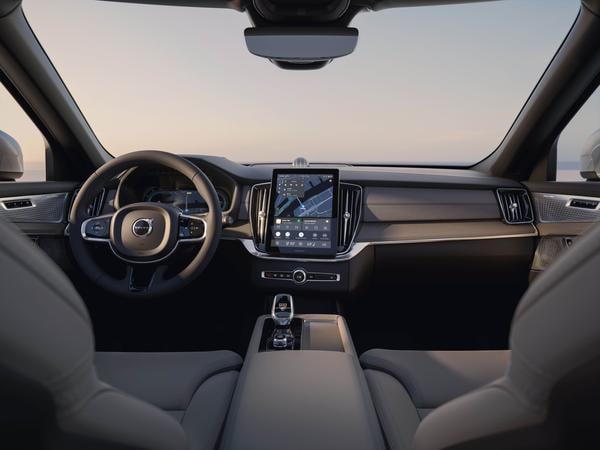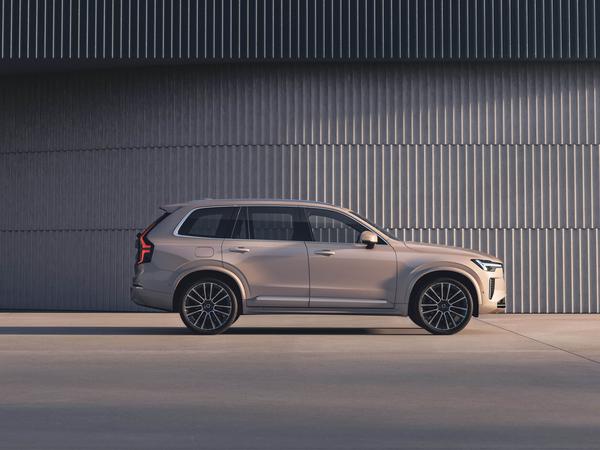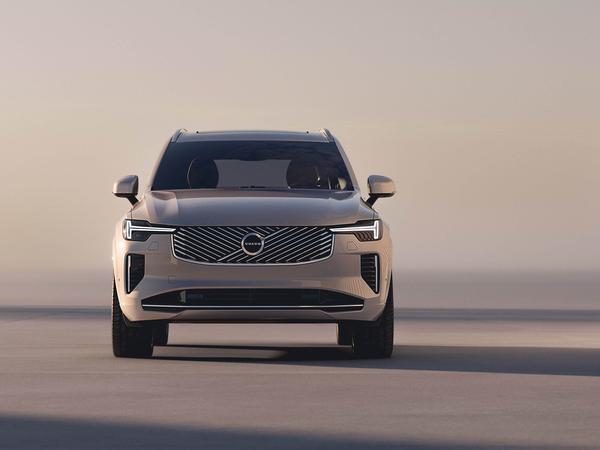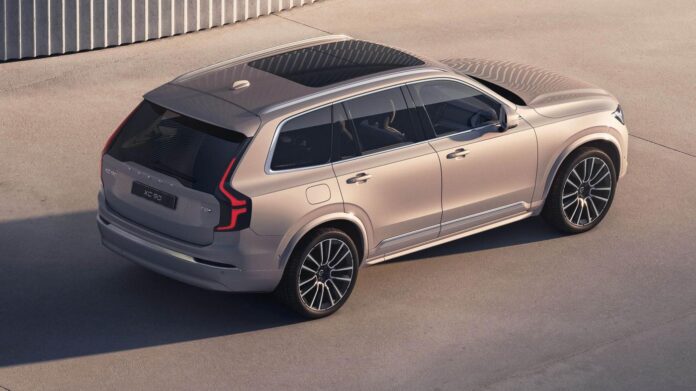A completely new front section with a wider grille, slimmer matrix LED headlights in Thor’s hammer design and air intakes, as well as a revised interior with an updated design, larger touchscreen and user-optimized functions – with the extensively revised premium SUV, Volvo wants to continue the success story of the XC90. Almost a million vehicles of the current version of the family car with up to seven seats in three rows have been sold so far. In Germany, Volvo’s large gasoline-powered XC90, the last facelift of which was presented in 2019, is in second place after the mid-range SUV XC60 with over 6,000 vehicles sold in the first half of 2024. The model is also very popular in the USA. The Swedish carmaker, which belongs to the Chinese Geely Group, therefore continues to see good sales prospects for the large SUV, even though the fully electric successor EX90 will be launched almost at the same time. It was originally expected that the XC90 with a combustion engine, built on an older platform, would therefore be discontinued.
Not fully electric by 2030
At the presentation of the new XC90, to which Volvo had invited, company boss Jim Rowan instead abandoned the stated goal of selling exclusively fully electric vehicles by 2030. It is not only the ongoing sales success of the XC 90 that has apparently contributed to the departure from the previous strategy. By 2025, every second new Volvo should be electric, it was previously said. To justify the change of course, Volvo boss Jim Rowan pointed to the changed market conditions, the partially inadequate charging infrastructure, and the current uncertainty among buyers due to possible additional tariffs and changed government incentives. Volvo is not alone in this. German manufacturers have also scaled back their electrification plans in recent months.
Electrification remains our North Star
Jim Rowan, CEO Volvo
“We firmly believe that our future is electric,” said Jim Rowan in Gothenburg. “However, it is clear that the transition to electrification will not be linear and customers and markets will have different speeds of acceptance. We are pragmatic and flexible while maintaining our industry-leading position in electrification and sustainability.” Volvo currently has four fully electric models and four plug-in hybrids in its range. In addition to the new flagship EX90, which can travel up to 620 km, the smaller SUV EX40 and the electric coupe EC40 are all purely electric. The small EX30, which was launched this year and stands for affordable and comfortable electromobility, is also a great sales success. Overall, Volvo’s share of fully electric vehicles will be 26 percent in the second quarter of 2024, the highest of all premium competitors.
Two new models announced
The goal has not been abandoned, even if Volvo currently expects only 90 percent of fully electric vehicles to be sold by 2030: Rowan has already announced the next fully electric model, the ES90 sedan. The new fully electric mid-range SUV EX60 is also due to be presented shortly. For this, Volvo is developing the completely new all-electric technology platform SPA3. In the future, all fully electric models will also use “Volvo Cars Superset” with a uniform IT architecture made up of systems, modules, software and hardware. “Superset” enables the software to be permanently updated with new functions “over the air”.

© Photo: Volvo
Contemporary looks, more comfort and an infotainment system suitable for a luxury class – all of this was on the order list for the facelift. It is noticeable that the Volvo designers obviously felt challenged by the unusual task of styling an in-house competitor to the premium brother EX90. Accordingly, the approach was taken with care, which can be seen in many details, but without abandoning the original design language of the XC90. The previous center console with the crystal gear lever for the eight-speed automatic has remained largely the same, while in the EX90 the center shelf has been radically cleared away except for the volume control and the small direction selector lever is located behind the steering wheel. It is good that the touchscreen above the center console is now significantly larger.
Simplified settings
It offers an Android-based infotainment system with integrated Google services and a voice assistant – which controls the air conditioning or navigation by voice command – while there is access to streaming services and other apps via the Google Play Store. The new user interface is therefore identical to that of the EX90 and the small EX30. Some cumbersome setting processes, for which users had to delve deep into the menu, have been simplified as part of the comprehensive software update. It is nice that the touchscreen also allows direct access to important vehicle functions via a button bar. The 12-inch driver information display behind the steering wheel can also display Google Maps for navigation.

© Photo: Volvo.
The upgraded interior looks more contemporary. This also applies to the materials used, where Volvo places great value on recycled materials. Users can choose between the pleasantly soft Nordico leather substitute or the woven Navy Herringbone Weave seat covering, each of which is developed and manufactured in-house from recycled textiles and plastic bottles. The interior of the standard seven-seater family vehicle is very light and spacious thanks to the optional panoramic roof, the front part of which can be opened at the push of a button. Unlike the fully electric EX90 with its flat vehicle floor under which the battery pack sits, a cardan tunnel in the XC90 reminds us that the 4.95-meter-long car is still built on a combustion engine platform and that a steel drive shaft to the rear axle is therefore necessary for the standard all-wheel drive AWD.
Seven seats as standard
Access to the third row of seats is made easier by the fold-away second row; there is enough space even for adults. The horizontal roofline also means that the XC90 has more headroom than its brother, the EX90, with its slightly sloping roof. If storage space is required, all seats can be folded down to form a flat surface – then up to 1830 liters of luggage space are available. On the tailgate, the light bar that is typical for Volvo and extends very high has been given a more dynamic curve.

© Photo: Volvo
The chassis now uses the double wishbone suspension newly developed for the EX90, which ensures first-class roadholding in the electric counterpart. However, the XC90 could not be driven. Of course, there is also a comprehensive safety package as standard. This includes Pilot Assist with automatic lane guidance and speed adjustment, an emergency braking assistant when obstacles are encountered in front of the car and Emergency Stop Assist, which automatically stops the car at the side of the road if the driver no longer responds to warnings, for example if they are unconscious.
Plug-in hybrid with more range
As before, the XC90 is powered by a four-cylinder petrol engine with turbo and is available as a plug-in hybrid with a permanent magnet electric motor. The combustion engine in the XC90 Plug-in Hybrid T8 AWD now produces 220 kW (310 hp), while the electric motor delivers 107 kW (145 hp). The purely electric range of the new XC90 has now increased to 72 kilometers, says Volvo. That is significantly more than users drive on average in a day, says the company. According to surveys by Volvo, the majority of drivers also choose the electric driving mode for normal everyday distances.
In addition, Volvo now also offers a mild hybrid four-cylinder petrol engine with turbo. The maximum output is 184 kW (250 hp). With a mild hybrid, fully electric driving is not possible; instead, a small electric motor only supports the combustion engine and thus reduces petrol consumption.
The price for the mild hybrid petrol B5 AWD in the basic Core version is 79,890 euros; the plug-in hybrid T8 AWD costs at least 87,490 euros. Both versions come as seven-seaters with three rows. Interestingly, the completely new all-electric EX90 in the basic version costs just 83,700 euros – but as a five-seater. The XC90 plug-in hybrid can also be leased for 1,119 euros per month.
